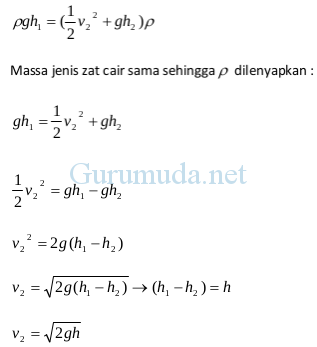Soal Venturi Meter Icpns. Hukum Bernoulli Rumus Bunyi Contoh Soal Pembahasan Lengkap. Contoh Soal Pembasan Gaya Angkat Sayap Pesawat Terbang Ardra Biz.
Venturi meters are flow measurement instruments which use a converging section of pipe to give an increase in the flow velocity and a corresponding pressure drop from which the flowrate can be deduced. They have been in common use for many years, especially in the water supply industry.
- Venturi meter Fluida yang mengalir dalam pipa mempunyai massa jenis ρ. Kecepatan fluida mengalir pada pipa sebelah kanan, maka tekanan pada pipa sebelah kiri lebih besar.
- Untuk kamu yang belajar fisika pasti sudah mengetahui rumus-rumus di atas sehingga kamu bisa menerapkannya pada kehidupan sehari-hari kamu. Terima kasih sudah membaca artikel saya kali ini dengan judul Simulator Venturimeter Yang Bisa Kamu Gunakan Untuk KeperluanSehari-Hari semoga atikel saya kali ini dapat membantu rekan-rekan sekalian.
- Venturimeter – contoh soal UN. Bagian pipa venturimeter yang lebih besar mempunyai luas penampang A 1 = 6 cm 2 dan bagian pipa yang lebih kecil mempunyai luas penampang A 2 = 5 cm 2.
- Venturimeter adalah sebuah alat yang bernama pipa venturi. Pipa venturi merupakan sebuah pipa yang memiliki penampang bagian tengahnya lebih sempit dan diletakkan mendatar dengan dilengkapi dengan pipa pengendali untuk mengetahui permukaan air yang ada sehingga besarnya tekanan dapat diperhitungkan.
The classical Venturi meter, whose use is described in ISO 5167-1: 1991, has the form shown in Figure 1
Figure 1. Classical Vetituri meter design. (From B. S. 7405 (1991) Fig. 3.1.4, with permission of B.S.I.)
For incompressible flow if the Bernoulli Equation is applied between two planes of the tappings,

Rumus Venturi Meter
where p, ρ and ū are the pressure, density and mean velocity and the subscripts 1 and 2 refer to the upstream and downstream (throat) tapping planes.
From continuity

whereis the volumetric flowrate and D and d the pipe and throat diameters.

Combining Eqs. (1) and (2)
Rumus Venturi Meter Measurement
where β is the diameter ratio, d/D. In reality, there is a small loss of total pressure, and the equation is multiplied by the discharge coefficient, C, to take this into account:

where Δp is the differential pressure (≡p1 − p2). The discharge coefficient of a Venturi meter is typically 0.985, but may be even higher if the convergent section is machined. Discharge coefficients for uncalibrated Venturi meters, together with corresponding uncertainties, are given in ISO 5167-1: 1991.
If the fluid being metered is compressible, there will be a change in density when the pressure changes from p1 to p2 on passing through the contraction. As the pressure changes quickly, it is assumed that no heat transfer occurs and because no work is done by or on the fluid, the expansion is isentropic. The expansion is almost entirely longitudinal and an expansibility factor, ε, can be calculated assuming one-dimensional flow of an ideal gas:
Rumus Venturi Meter Definition
where τ is the pressure ratio, p2/p1, and κ the isentropic exponent. The expansibility factor is applied to the flow equation in the same way as the discharge coefficient.

Various forms of construction of a Venturi meter are employed, depending on size, but all are considerably more expensive than the orifice plate. However, because most of the differential pressure is recovered by means of the divergent outlet section, the Venturi causes less overall pressure loss in a system and thus saves energy: the overall pressure loss is generally between 5 and 20 per cent of the measured differential pressure. The Venturi meter has an advantage over the orifice plate in that it does not have a sharp edge which can become rounded; however, the Venturi meter is more susceptible to errors due to burrs or deposits round the downstream (throat) tapping.
Rumus Venturi Meter Pulse
The lengths of straight pipe required upstream and downstream of a Venturi meter for accurate flow measurement are given in ISO 5167-1: 1991. These are shorter than those required for an orifice plate by a factor which can be as large as 9. However, Kochen et al. show that the minimum straight lengths between a single upstream 90° bend and a Venturi meter in the Standard are too short by a factor of about 3.
REFERENCES
British Standards Institution (1991) Guide to selection and application of flowmeters for the measurement of fluid flow in closed conduits, BS 7405.
International Organization for Standardization, Measurement of fluid flow by means of pressure differential devices—Part 1: Orifice plates, nozzles and Venturi tubes inserted in circular cross-section conduits running full. ISO 5167-1: 1991.
Kochen, G., Smith, D. J. M., and Umbach, A. (1989) Installation effects on Venturi tube flowmeters, Intech Engineers Notebook, October 1989,41-43.
References
Rumus Venturi Meter Valve
- British Standards Institution (1991) Guide to selection and application of flowmeters for the measurement of fluid flow in closed conduits, BS 7405.
- International Organization for Standardization, Measurement of fluid flow by means of pressure differential devices—Part 1: Orifice plates, nozzles and Venturi tubes inserted in circular cross-section conduits running full. ISO 5167-1: 1991.
- Kochen, G., Smith, D. J. M., and Umbach, A. (1989) Installation effects on Venturi tube flowmeters, Intech Engineers Notebook, October 1989,41-43.